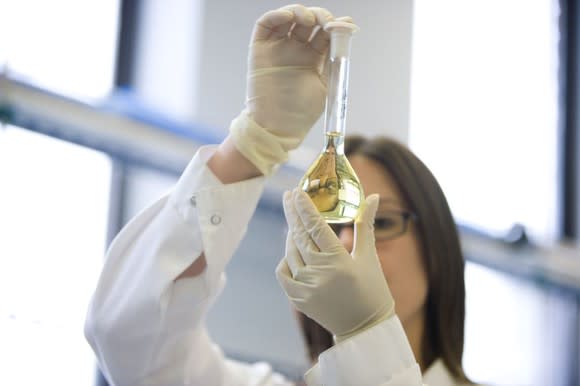Despite Losing $88 Million in Q2, This Pot Stock Still Has More Cash Than Any of Its Peers
The marijuana industry may be growing at an exceptionally fast pace, but that doesn't mean it's exempt from challenges. Chief among those challenges for marijuana stocks is securing the capital needed to build their businesses.
You see, most pot companies don't have access to basic banking services such as lines of credit, loans, or even something as simple as a checking account. The reason for this (at least in the U.S.) is simple: Cannabis is an illegal drug. Because of that, financial institutions fear the monetary and/or legal repercussions of providing banking services to businesses involved in the cannabis industry. This can leave marijuana stocks in a bit of a bind, especially since many of them still are losing money.

Image source: Getty Images.
This pot stock has a fat wallet
However, one pot business has built itself quite the mountain of cash. In fact, even after losing $88 million in its recently reported second-quarter results, this company still has far more in cash and cash equivalents than the next-closest cannabis company. Ladies and gentlemen, this cash kingpin is none other than cannabinoid-based drugmaker GW Pharmaceuticals (NASDAQ: GWPH).
Last Tuesday, May 8, GW Pharmaceuticals announced $3.35 million in sales, predominantly tied to Sativex, a cannabinoid-based drug approved in more than a dozen European countries to treat spasticity associated with multiple sclerosis (MS). However, considerably higher research and development expenditures, sales, general, and administrative expenses, and net foreign exchange losses relative to Q2 2017 pushed the company's net loss to $88 million for the quarter.
Yet in spite of its massive quarterly loss, U.K.-based GW Pharmaceuticals ended Q2 with $487.2 million in cash and cash equivalents. That's up by almost 44% from the prior-year quarter, inclusive of its $88 million loss.
By comparison, the next-closest pot stocks in terms of cash and cash equivalents are Canadian cannabis growers, including Aurora Cannabis and Canopy Growth Corp. Aurora Cannabis and Canopy Growth have approximate cash balances of $332.8 million and $311.2 million, respectively, at their disposal as of the latest quarter, inclusive of any reported capital raises via bought-deal offerings. That's how far ahead of the field GW Pharmaceuticals is in terms of total cash balance.

Image source: GW Pharmaceuticals.
Why GW Pharmaceuticals needs so much cash
You might be wondering why a company like GW Pharmaceuticals needs so much cash. It essentially boils down to two reasons.
1. The expected launch and marketing of Epidiolex
To begin with, GW Pharmaceuticals is preparing for the commercial launch of Epidiolex, a cannabidiol (CBD)-based treatment for two rare types of childhood-onset epilepsy -- Dravet syndrome and Lennox Gastaut syndrome. CBD is the non-psychoactive component of the cannabis plant, best known for its medical benefits.
In a handful of phase 3 studies, Epidiolex handily met its primary endpoint, which was to produce a statistically significant reduction in seizure frequency from baseline relative to the placebo. In one pivotal study for Dravet syndrome, the reduction in seizure frequency from baseline was 39%, which was three-times greater than the 13% reduction produced by the placebo.
What's more, the Food and Drug Administration's (FDA) advisory panel recently reviewed the clinical data for Epidiolex as presented in its new drug application and voted unanimously that it should be approved. Understand the FDA isn't required to follow the advice of its panel, but it tends to do so more often than not.
With a PDUFA decision date set for June 27 and a better than 50-50 shot at approval, GW Pharmaceuticals needs its cash, in my opinion, to launch and market Epidiolex in the hope of one day growing it into a blockbuster drug.

Image source: Getty Images.
2. The expansion of GW Pharmaceuticals' portfolio and pipeline
The other reason GW Pharmaceuticals needs so much cash is to run additional clinical studies to expand its pipeline and product portfolio. That's the thing about drug developers -- the spending on research never stops.
For example, part of the thesis for turning Epidiolex into a blockbuster drug is label-expansion opportunities. Midstage trials are underway that are examining its use as a treatment for infantile spasms. Also, phase 3 studies for tuberous sclerosis involving Epidiolex are ongoing, with a data readout expected in the first half of 2019.
Beyond Epidiolex, GW Pharmaceuticals has an array of early-stage, midstage, and late-stage studies to run with. Sativex for spasticity in MS is being examined in a late-stage U.S. study, while GWP42006, a promising cannabidivarin-based compound, is being looked at as a possible treatment for epilepsy and autism spectrum disorders.
Having plenty of cash on hand ensures that these studies will be run without shareholders worrying about a cash crunch.

Image source: Getty Images.
Epidiolex is what matters (for now)
For the time being, though, all eyes are on Epidiolex and its expected approval and launch. Some Wall Street firms believe Epidiolex has the potential to cross $1 billion in peak annual sales. After all, it's on track to be the first approved treatment for Dravet syndrome and a clearly beneficial treatment for Lennox-Gastaut patients.
The big question is: Will this first-to-market advantage hold up against the competition? To that end, I'm not entirely certain.
Back in September, drug developer Zogenix (NASDAQ: ZGNX) announced data from ZX008 in late-stage trials that absolutely wowed Wall Street. ZX008, which is a low-dose fenfluramine, led to a 72.4% reduction in seizure frequency from baseline over a 14-week testing period. This compared very favorably with a 17.4% reduction in seizure frequency from baseline observed with the placebo.
Though Zogenix's drug and Epidiolex haven't gone head-to-head, it might be difficult for physicians and patients to overlook the strength of these results. Plus, Zogenix has plans to expand ZX008 into Lennox-Gastaut, as well.
In short, even with all of its cash and a likely FDA approval for Epidiolex, GW Pharmaceuticals isn't guaranteed success. That's something shareholders should keep in mind.
More From The Motley Fool
Sean Williams has no position in any of the stocks mentioned. The Motley Fool has no position in any of the stocks mentioned. The Motley Fool has a disclosure policy.
